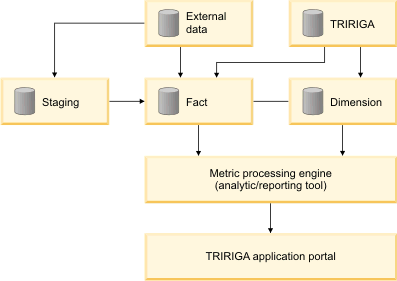Metrics structure
The TRIRIGA® Workplace Performance Management functionality focuses on capturing metric facts and enabling metric reporting.
Most TRIRIGA metrics are multidimensional, where the same metric provides a high-level summary view (for example, the Total Operating Cost/Area for the entire organization and portfolio) and, by drill down through various dimensions or filters, a role-specific view (for example, Total Operating Cost/Area for North American Operations for the facilities that are managed by North American operations).
Metrics measure process performance that is capable of identifying actionable results. Typically, the measures are ratios, percentages, or scores. Metrics have targets, thresholds, action conditions, accountability, and action task functionality.
- Customer Metrics
- Measure customer satisfaction
- Financial Metrics
- Measure financial performance
- Portfolio Metrics
- Measure operational utilization and asset life cycle health
- Process Metrics
- Measure process efficiency and effectiveness
- Reporting and Analysis Metrics
- Analyze a specific performance metric
- Environmental
- Measure performance of environmental initiatives
- Building meters
- Measure characteristics of a building as reported by meters and sensors
The following high-level process diagram depicts how metrics are defined, captured, and presented to the user:

The TRIRIGA database is the primary source of data for gathering operational data to be loaded into fact tables. Optionally, you can extract data from other sources to be loaded into fact tables.
Each fact table contains the lowest level of aggregated data (such as Building level) for each metric category. For efficiency reasons, a fact table is a de-normalized (flattened) table containing data elements from multiple TRIRIGA tables.
The dimension table contains dimensions for each metric. Dimensions are stored in a separate table for efficiency. The fact table contains a key (Spec ID) for each dimension. The dimension table can be either a flat hierarchy table or an TRIRIGA business object table.
The Metric Processing Engine (Analytic/Reporting Tool) generates metrics using data stored in fact tables along with metric setup data and dimension data.
Metric data, along with notifications, actions, and alerts, are presented to users in a role-based portal in various forms (including reports, queries, and graphs) as defined in the metric setup table. A user can drill down into a specific object or drill path to further analyze the metric data presented to them.
Metric reporting is dependent on metric fact tables. These fact tables are implemented using the Data Modeler but are identified with a unique object type that signifies that it is a metric object. Metric objects are populated using an ETL development environment, which is different from all other object types that are updated through the metadata layer. The scheduling of the ETL process is controlled from within the TRIRIGA system using the Job Scheduler.